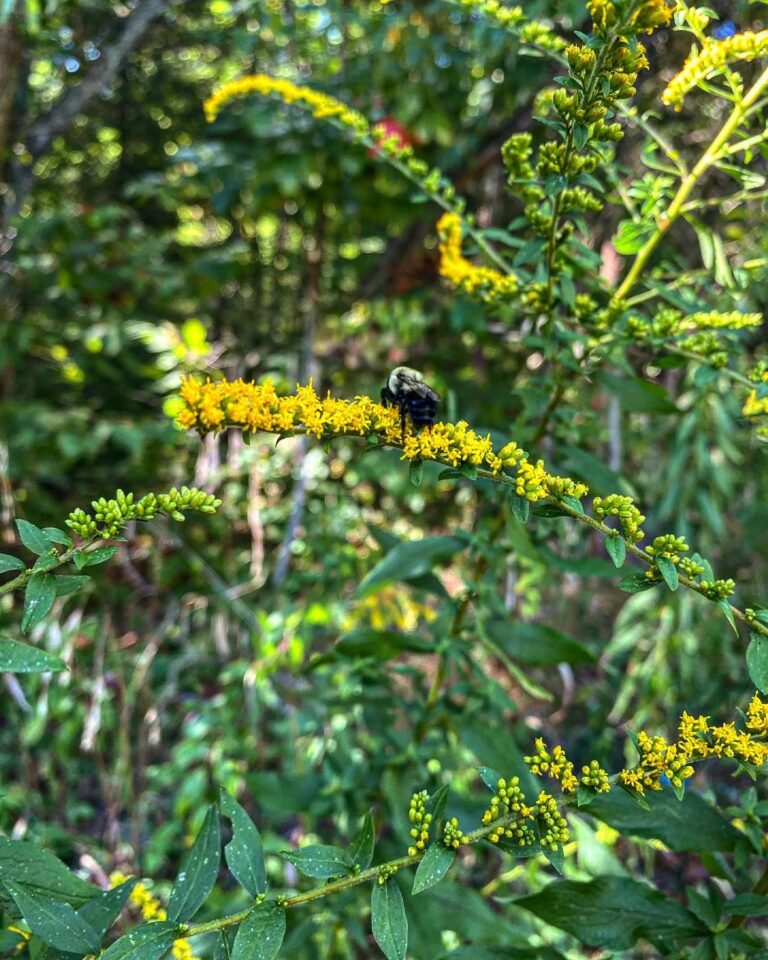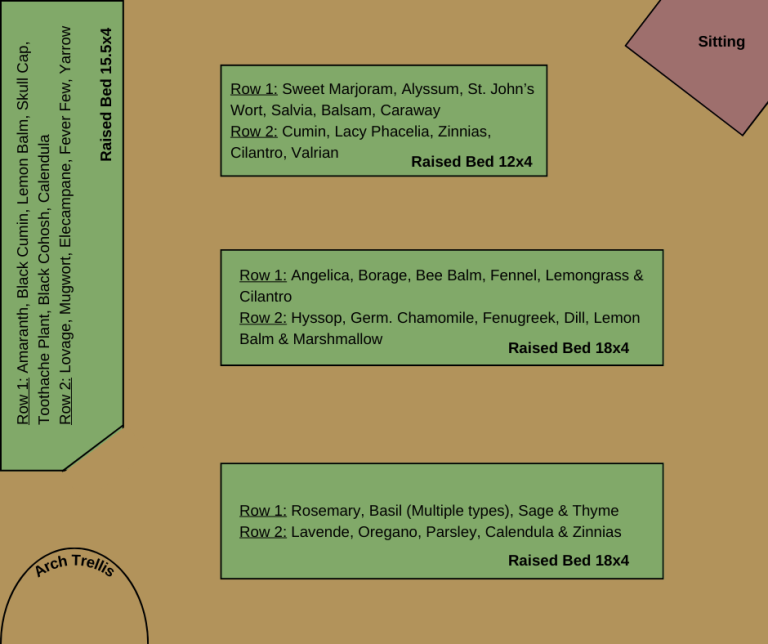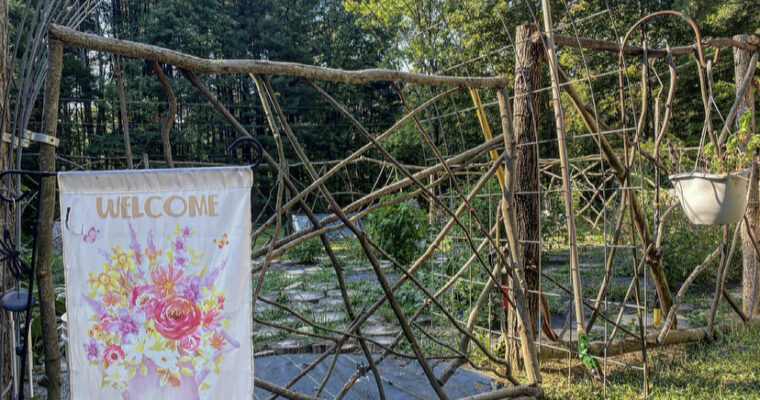**Some posts on the Wolterman Homestead contain affiliate links. When you make a purchase through an affiliate link, your price will be the same, but the Wolterman Homestead will receive a small commission. Thank you for your support!**
Gardening has been a passion of mine for years, but more recently, herbalism has taken root in my heart. The idea of returning to the biblical way of nurturing and nourishing the body as God intended has become a guiding principle for me.
When we moved to this property almost two years ago, I knew that establishing a medicinal herb garden was a major goal I wanted to pursue. It took hard work and dedication, but now, it’s become one of my sanctuaries. The love for herbalism that grew within me has inspired me to chase my dream of becoming a certified herbalist.
In the Bible, herbs and plants are often mentioned for their use in healing, nourishment, and as a reminder of God’s provision. A Biblical perspective on gardening doesn’t just view plants as a source of sustenance but as a way to connect with God’s creation, embrace holistic health, and bring beauty into the world. In this blog, we will explore how to plan a medicinal herb garden, rooted in Biblical teachings and principles.

Golderod (Solidago virgaurea var. leiocarpa)
Begin with Stewardship
From the very beginning, Scripture teaches us about the responsibility and beauty of tending the earth. In Genesis 2:15, God places Adam in the Garden of Eden and commands him to “work it and take care of it.” This sets the stage for a Biblical understanding of gardening — it’s not just about the plants themselves but how we care for them and the land. This mindset transforms the act of gardening into a sacred, purposeful activity that connects us to God’s original design.
Biblical Reflection:
The concept of stewardship extends far beyond the physical act of planting—it encompasses so much more. It means taking responsibility for what God has entrusted to us, much like the 40 acres of land He has given us. This land was given to us for a reason. The property we had initially hoped for was destroyed by a tornado and now faces water issues. The number 40 holds biblical significance, often representing a time of trial and testing. For example, Noah endured 40 days and nights in the ark as it rained. The Israelites spent 40 years in the desert, and Yeshua (Jesus) faced 40 days of testing and temptation by Satan in the wilderness.
In our own trials and testing, we’ve found blessings and beauty. We’ve been called to share what God has given us in different ways, such as through the wild medicinal foraging class we offered last year. This provided others with an opportunity to learn how to identify and understand various wild medicinal plants. Above all, God has called us to be good stewards of our health and well-being. Growing medicinal herbs is one way we can honor God’s creation and care for our bodies as temples of the Holy Spirit. (1 Corinthians 6:19-20).
Choose Herbs that Promote Health and Healing
The Bible contains many references to plants that offer medicinal properties, some of which have been used for centuries. For example, in Ezekiel 47:12, God promises that the leaves of the trees will be “for the healing of the nations.” Many of the herbs found in the Bible are known for their medicinal qualities and can be grown in a garden to benefit our physical and spiritual health.
Biblical Medicinal Herbs to Include in Your Garden:
- Aloe Vera (Aloe barbadensis miller): Known for its healing properties, aloe vera has been used to treat burns, skin irritations, and other wounds. In the Bible, aloe was used in embalming (John 19:39), highlighting its significance in both healing and preservation. (Avoid during pregnancy, Laxative)
- Balm of Gilead (Commiphora wightii): A plant referenced in Jeremiah 8:22, often associated with healing and comfort. Its resin has been used in traditional medicine for its soothing properties.
- Frankincense (Boswellia sacra) and Myrrh (Commiphora wightii): These two aromatic resin-producing plants were valuable in biblical times for their use in incense and as healing agents (Matthew 2:11). They have anti-inflammatory and antimicrobial properties. (Avoid both during pregnancy, Bioactive)
- Cilantro (Coriandrum sativum): This herb is mentioned in Exodus 16:31 as manna, the food provided to the Israelites in the wilderness, and is known for its antioxidant and detoxifying qualities.
- Mint (Mentha): Yeshua/Jesus refers to mint in Matthew 23:23 as part of the “smallest” herbs that the Pharisees tithed, showing that even small plants have significance in God’s eyes. Mint can be used to soothe digestive issues and freshen the breath.
- Hyssop (Hyssopus offinalis): Often used as a symbol of purification, cleansing, and healing. It is used in rituals of purification, particularly in the Torah (Old Testament). (Exodus 12:22, Leviticus 14:4-7, & John 19:29). (Avoid during pregnancy, Bioactive)
When choosing herbs, consider their medicinal qualities and how they can benefit you and your family. The Bible encourages us to be wise in our choices and to use creation for our good (Genesis 1:29).
Design the Garden Layout with Intent
Planning your garden involves more than just choosing plants—it’s about creating a space that serves a purpose and reflects God’s design. A well-thought-out garden not only provides medicinal herbs but can also become a place for prayer, reflection, and meditation.
Biblical Gardening Principles for Layout:
Unity with Creation: The layout of your garden should reflect harmony with nature. Consider planting in groups or patterns that mirror natural ecosystems, where herbs grow together in symbiotic relationships. This honors God’s design for biodiversity (Genesis 1:12).
Purposeful Paths: A well-organized garden may include paths that allow for easy access to your herbs. These paths can also symbolize our journey of faith, as we walk the way of healing and restoration. Isaiah 40:3 speaks of preparing a way, “a highway for our God,” and this can inspire the creation of a pathway to the plants that promote healing.
Sunlight and Shade: In the Bible, the light of God is a theme of guidance and growth (Psalm 119:105). Just as plants need sunlight to thrive, we too need the “light” of God’s Word to grow spiritually. Ensure that your garden provides adequate sunlight for herbs that require it, while also considering shade for those that thrive in lower light conditions.
What I’m Planting & My Herbal Garden Layout
Here is the layout that I’m thinking about doing this year. The fence is getting a change, but the beds will remain the same. I’m sure things will change but here are some plant details!
Bed #1 (18 ft x 4 ft) – Aromatic & Mediterranean Herbs
Row 1 (Left to Right):
- Rosemary (Rosmarinus officinalis) (18–24 inches apart)
- Basil – Cinnamon (Ocimum basilicum ‘Cinnamon’) (12 inches apart)
- Basil – Genovese (Ocimum basilicum ‘Genovese’) (12 inches apart)
- Basil – Lemon (Ocimum basilicum ‘Lemon’) (12 inches apart)
- Sage – Broad Leaf (Salvia officinalis ‘Berggarten’) (18–24 inches apart)
- Thyme (Thymus vulgaris) (12 inches apart)
Row 2 (Left to Right):
- Lavender (Lavandula angustifolia) (18–24 inches apart)
- Oregano (Origanum vulgare) (12 inches apart)
- Mint (Note: There are many varieties of mint, such as Mentha spicata for spearmint and Mentha piperita for peppermint. Needs contained in pots) (12–18 inches apart)
- Parsley (Petroselinum crispum) (6–8 inches apart)
- Calendula – Pacific Beauty Mix (Calendula officinalis) (12–18 inches apart)
- Zinnias (Zinnia elegans) (12–18 inches apart)
Bed #2 (18 ft x 4 ft) – Healing & Medicinal Herbs
Row 1 (Left to Right):
- Angelica Archangelica (Angelica archangelica) (18–24 inches apart)
- Borage (Borago officinalis) (12–18 inches apart)
- Bee Balm (Lemon) (Monarda citriodora) (18–24 inches apart)
- Fennel (Foeniculum vulgare) (12–18 inches apart)
- Lemongrass (Cymbopogon citratus) (18–24 inches apart)
- Cilantro (Coriandrum sativum) (6–8 inches apart)
Row 2 (Left to Right):
- Hyssop (Hyssopus officinalis) (12–18 inches apart)
- German Chamomile (Matricaria chamomilla) (12–18 inches apart)
- Fenugreek (Trigonella foenum-graecum) (12–18 inches apart)
- Dill – Long Island Mammoth (Anethum graveolens) (12–18 inches apart)
- Lemon Balm (Melissa officinalis) (12–18 inches apart)
- Marshmallow (Althaea officinalis) (18–24 inches apart)
Bed #3 (12 ft x 4 ft) – Culinary & Medicinal Herbs for Tea and Healing
Row 1 (Left to Right):
- Sweet Marjoram (Origanum majorana) (12–18 inches apart)
- Sweet Alyssum (Lobularia maritima) (6–8 inches apart)
- St. John’s Wort (Hypericum perforatum) (18–24 inches apart)
- Salvia – Blue Bedder (Salvia farinacea) (12–18 inches apart)
- Balsam Peppermint Stick (Monarda didyma) (12–18 inches apart)
- Caraway (Carum carvi) (6–8 inches apart)
Row 2 (Left to Right):
- Cumin (Cuminum cyminum) (12–18 inches apart)
- Hyssop (Hyssopus officinalis) (12–18 inches apart)
- Lacy Phacelia (Phacelia tanacetifolia) (6–8 inches apart)
- Zinnias (Zinnia elegans) (12–18 inches apart)
- Cilantro (Coriandrum sativum) (6–8 inches apart)
- Valerian (Valeriana officinalis) (18–24 inches apart)
Bed #4 (15.5 ft x 4 ft) – Tall Medicinal and Aromatic Herbs
Row 1 (Left to Right):
- Amaranth (12–18 inches apart)
- Black Cumin (Nigella sativa) (12–18 inches apart)
- Lemon Balm (Melissa officinalis) (12–18 inches apart)
- Borage (Borago officinalis) (12–18 inches apart)
- St. John’s Wort (Hypericum perforatum) (18–24 inches apart)
Row 2 (Left to Right):
- Lovage (Levisticum officinale) (18–24 inches apart)
- Mugwort (Artemisia vulgaris) (18–24 inches apart)
- Rosemary (Rosmarinus officinalis) (18–24 inches apart)
- Fennel (Foeniculum vulgare) (12–18 inches apart)
- Valerian (Valeriana officinalis) (18–24 inches apart)
- Zinnias (Zinnia elegans) (12–18 inches apart)
Planting Tips:
- Spacing: Ensure you follow the recommended spacing for each herb to avoid overcrowding. This will allow for air circulation and healthy growth.
- Watering: While these herbs thrive in full sun, remember to provide adequate water, especially during the hotter months. Drip irrigation is an efficient way to keep your herbs hydrated.
- Soil: These plants prefer well-drained soil. Consider adding compost or organic matter to improve soil quality and drainage.
- Companion Planting: Herbs like basil, oregano, and rosemary are great companions. Mint should be contained as it can spread aggressively.
- Mulching: Use mulch around your herbs to help retain moisture and prevent weeds, especially during the summer months.

Practice Sustainable Gardening
Sustainability is a key part of Biblical stewardship. Proverbs 12:10 teaches that “a righteous man cares for the needs of his animal,” and this extends to the broader practice of caring for the earth. Sustainable gardening practices, such as composting, water conservation, and using organic methods, reflect our responsibility to care for the environment.
- Composting: Turn kitchen scraps, plant clippings, and natural waste into nutrient-rich compost to feed your garden, reducing waste and enriching the soil. This mirrors the cyclical nature of life that God established.
- Rainwater Harvesting: Collecting rainwater for your garden conserves resources and minimizes your environmental impact. This aligns with the Biblical principle of being mindful stewards of the earth’s resources.
Harvest and Use with Gratitude
As you harvest the medicinal herbs you’ve grown, remember that these plants are gifts from God, meant for our nourishment and healing. Always approach your harvest with gratitude, recognizing the Creator’s provision in every leaf, stem, and root.
In Deuteronomy 8:10, God tells the Israelites, “When you have eaten and are satisfied, praise the Lord your God for the good land he has given you.” Just as the Israelites were to acknowledge God’s provision, we too can be grateful for the herbs in our garden, which reflect God’s goodness and care.

A medicinal herb garden, when planned with a Biblical foundation, becomes more than just a source of plants—it becomes a ministry of healing, a reminder of God’s faithfulness, and a way to honor Him through stewardship. By carefully selecting your herbs, designing with purpose, and tending to the earth with love and gratitude, you can create a space that nurtures both body and soul, grounded in faith and Biblical wisdom.
In planning out your herbal medicinal garden, please be mindful of what herbs you’re planting. Always consult a medical professional before using medicinals. Some herbs can cause allergic reactions. Many herbs should only be used topically vs internally (Comfrey is an example of that. It is heavy in pyrrolizidines alkaloiads (PAs), which can cause liver damage.). Research, research, RESEARCH!

“The earth brought forth grass, plants each yielding its own kind of seed, and trees each producing its own kind of seed-bearing fruit; and God saw that it was good.” – Genesis 1:12

Leave a Reply